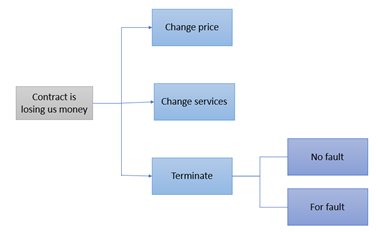
How to review and use your contracts in uncertain times

This guide will look at how you can review your contracts to provide for times of uncertainty. Before we go into the mechanisms that you can use to do this, it's important to first consider the current economic outlook for 2023 and beyond.
The one thing that's certain seems to be uncertainty...
The International Monetary Fund recently downgraded the UK economy's growth to a contraction of 0.6% but beyond that there seems to be a lot of disagreement about whether we have or haven’t seen off the risk of recession.
What does seem certain is that the foreseeable future seems characterised by high inflation and rising interest rates to combat it. Recent headlines have noted a surprise increase to inflation of 10.4% and financial rating house Standard and Poors has been quoted as saying:
"As double-digit inflation and much higher costs of borrowing continue to feed through, the UK's economic situation is set to worsen slightly, in our view, before it starts improving later this year,”
“We now expect the UK economy to shrink by 0.5% this year. Falling private consumption and investment will be only partly offset by growth in government consumption and a positive contribution from net trade.”
Businesses have a number of things to think about in that kind of environment but one thing this article wants to highlight is the ability to use contractual levers to share risk.
Well drafted contracts can help businesses provide for the unexpected
We see a lot of clients, in various industries, operating under contracts where pricing and the scope of services were agreed in a much more benign trading and economic environment than now prevails. A lot of those contracts are well drafted but just didn’t contemplate the perfect storm of circumstances we have all lived through, whether its Brexit, Covid-19, the disruption to global trade caused by the blocking of the Suez Canal, the invasion of Ukraine, or the impact on energy prices.
In a lot of contexts, particularly those with high energy usage, we are seeing flashpoints as businesses seek to pass through their cost increases. The purpose of this article is to identify how having well drafted contracts and actually dusting those off and using them can help businesses provide for and pivot after some of these unexpected events.
At its simplest form, there's quite a limited number of choices open to you when you're in a contract and its losing you money. These can be summarised like this:

However, bear in mind two things. The first is there are lots of different ways you can deal with each of those three methods of talking the problem. The second is to access any of them in a straightforward and cost-effective way you need the right drafting.
Change price
| Ways to deal | How does it help? |
| Price increase (for any reason) | A price adjustment clause allows a party to increase the charges annually either for any reason, or for specified reasons, by giving written notice to the customer. This is the most favourable form of price increase mechanism for the receiving party |
| Annual price increase (by recognised price index) | An indexation clause allows a party to increase the charges annually by reference to a recognised price index (often say RPI or CPI or an energy index. *=Beware choosing the "wrong" index: for instance, we've seen clauses in industrial agreements with electricity price increases linked to consumer indices, which were then capped where the supplier's cost of energy was not capped. |
| Price increase (due to inflation) | This clause allows a party unilaterally to increase the charges due to inflation. |
| Price increase (at any time due to increases in the costs of raw materials, labour, transportation etc.) | This clause allows a party unilaterally to increase charges at any time due to increased costs of raw materials, labour, transport or other such items. |
| Price increase (due to a change in law or regulation) | This clause allows a party to impose a price change due to a change in law or regulation. |
| Price review | This clause provides that the parties will regularly review the prices for the services. The parties must agree to any increases to the charges. |
Change services
| Ways to deal? | How does it help? |
| Force Majeure (if well drafted) can provide a "pause" while unexpected circumstances prevail and a defence to a claim for breach | A mutual force majeure clause which includes a wide definition of force majeure events can allow the affected party will be excused from or entitled to suspend the performance of certain obligations under the contract after the occurrence of such an event. |
| Material adverse change clauses are usually intended to provide protection from unforeseen events or circumstances which have a detrimental impact on the parties to a contract. Where an unforeseen event or circumstance occurs within the scope of the clause and which has a material adverse effect on the rights and/or obligations of one or more of the parties, this may trigger a right to require the parties to renegotiate specific aspects of the contract or even a right permitting a party to terminate the contract in its entirety. | |
| Change control procedure | Lots of contracts contain a standard change control procedure which allows the relevant party to propose a change to the scope of the contract (i.e. to add or remove service lines) including any changes to the charges for the services. Such changes will need to be agreed with the relevant customer or dealt with under the dispute resolution procedure under the relevant contract. |
Terminate
| Ways to deal? | How does it help? |
| Expiry of a fixed term or initial term | This is the most straightforward way to exit an agreement, |
| No fault termination | Parties often provide that either side can terminate for any reason by giving a set period of notice. |
| Termination for fault. | Contracts will very commonly provide that they can be terminated for a material breach of contract. Often, they will provide for a cure period to allow breaches which are capably to be cured to be cured so as to avoid termination. |
| Termination on other specified reason. | You will often see a clause permitting termination for eg a number of repeated non material breaches, or the entry into an insolvency event, or a change in control of the other party, etc. |
| Future Change | A change in law clause can allow for example a right to terminate or renegotiate in the event of an anticipated (or unanticipated change of law). |
There are lots of ways you can provide for future uncertainty. Where you don’t have the contractual drafting to give you this sort of flexibility legally speaking you need to get creative. Often you can end up trying to argue that there has been a material breach of contract either as a route to terminate or in the hope that the leverage of that threat, in time, cost and risk of losing such a dispute is sufficient leverage to renegotiate. That route is often used successfully but it invariably entrenches disputes, damages relationships and necessitates material legal costs on each side.
How we can help
Foot Anstey has a playbook of clauses to deal with all of these issues which you can roll out into contracts. The past few years have either taught us to expect the unexpected or at least to recognise how a series of events can produce unpredictable results. Where the bargaining strength in negotiating a contract permits it, there are some clauses that can give businesses really significant flexibility to deal with uncertain times.






